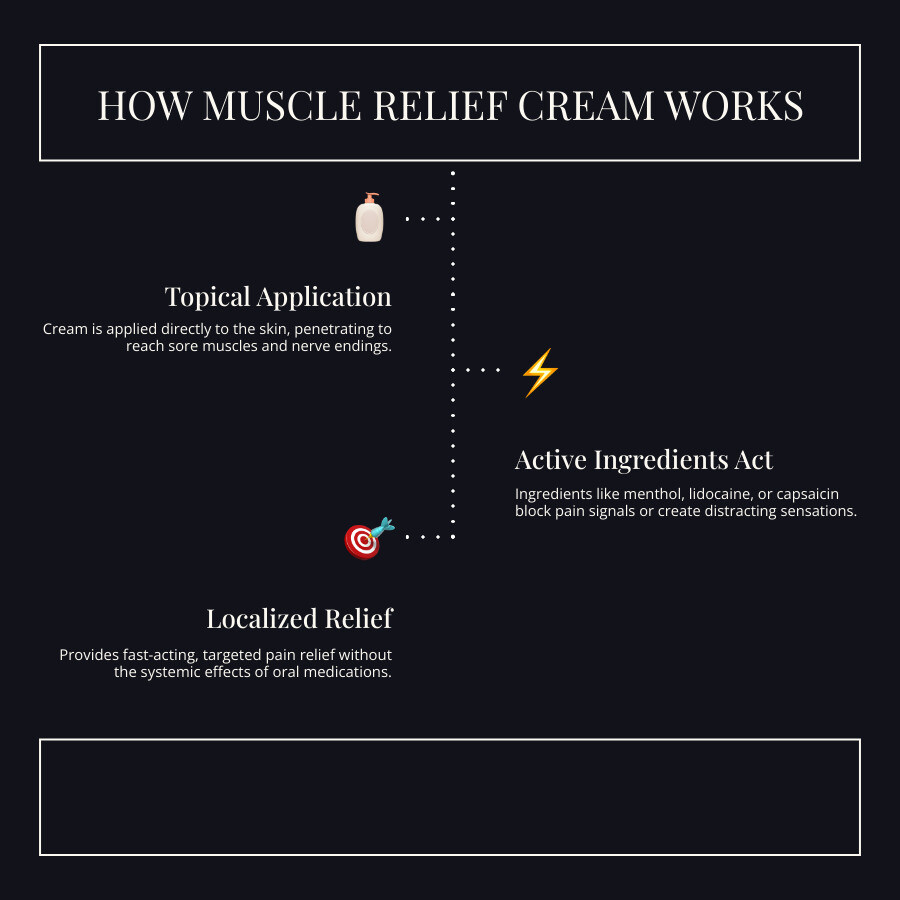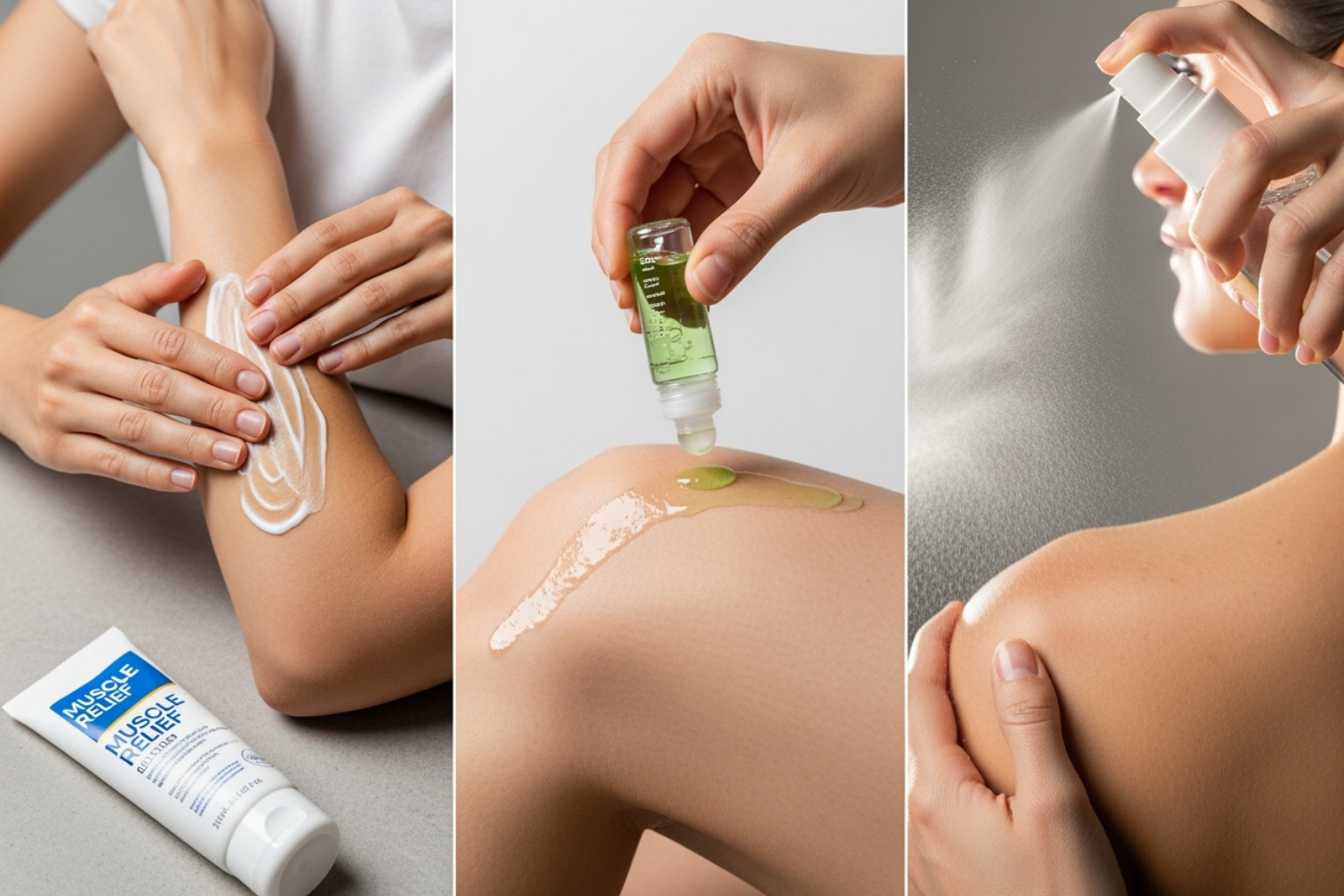Why Muscle Relief Cream Matters for Pain Management
Muscle relief cream is a topical product applied directly to the skin to relieve pain in muscles and joints. It works by delivering active ingredients that block pain signals, create cooling or warming sensations, or numb the area, offering an alternative to oral medication.
Quick Answer: What You Need to Know About Muscle Relief Creams
- How They Work: Block pain signals with ingredients like menthol, lidocaine, or capsaicin.
- Best For: Mild to moderate muscle soreness, arthritis, strains, and localized pain.
- Key Ingredients: Menthol (cooling), camphor (warming), lidocaine (numbing), arnica (anti-inflammatory).
- Application Types: Creams, gels, roll-ons, sprays, and patches.
- Safety: Lower risk of systemic side effects than oral medications; may cause skin irritation.
- Effectiveness: Provides temporary relief by interfering with pain signals; does not heal muscle tissue.
If you've ever pushed through a tough workout, you know the feeling of screaming muscles and aching joints. Over-the-counter muscle rubs can be highly effective for managing this type of mild to moderate soreness. Research from sources like the Mayo Clinic shows topical NSAIDs have a lower risk of stomach and heart problems compared to oral versions, working best on muscles close to the skin.
However, the pain relief aisle can be overwhelming with its cooling, warming, and "maximum strength" options. Understanding the ingredients and how they work is key to choosing the right product.
I'm Tony Enrico, and I've spent years developing Neuropasil's advanced muscle relief cream. Our goal is to help 1 million people across North America find lasting, natural relief by 2028.

How Topical Pain Relievers Work
When you feel pain, it's because nerve endings have sent a signal to your brain. Muscle relief cream works by interrupting this communication. By delivering active ingredients directly through the skin, it targets discomfort at the source, unlike oral medications that travel through the entire bloodstream. This localized effect means the medicine works right where you hurt.
Many of these creams are counterirritants. They create a new cooling or warming sensation that distracts your brain from the original pain. This is explained by the gate control theory of pain, where non-painful sensations can "close the gate" on pain signals. Other topicals contain anesthetics like lidocaine to numb nerve endings directly, or anti-inflammatory ingredients to reduce swelling.
The effectiveness of a muscle relief cream depends on its ability to penetrate the skin and reach the underlying muscles. Quality formulas use specific carriers to improve absorption and deliver active ingredients where they're needed most.
For more insights into managing everyday aches, check out our article on Muscle Aches.
The Science of Sensation: Cooling vs. Warming
Pain relief products generally offer either a cooling or warming effect. Both are strategic approaches to pain management.
Cooling sensations come from ingredients like menthol and camphor. When applied, menthol stimulates cold receptors, sending competing signals to the brain that can override pain messages. This creates a refreshing distraction and can reduce blood flow to the area, contributing to the cooling effect. Professional-grade formulas may contain up to 16% menthol for a powerful cooling punch.
Warming sensations use ingredients like capsaicin, derived from chili peppers. Capsaicin depletes Substance P, a chemical that transmits pain signals, according to scientific studies. The warmth increases blood flow, delivering oxygen to help muscles relax and reduce stiffness. As noted by medical resources like the Cleveland Clinic, capsaicin works best with consistent use, often requiring several daily applications for up to two weeks to achieve its full effect.
Whether you prefer an icy blast or comforting heat, both sensations aim to provide temporary relief from muscle and joint pain. To learn more, explore our guide on what helps sore muscles.
Do They Heal Muscles or Just Mask Pain?
Does muscle relief cream heal muscles or just cover up the pain? The answer is that these creams primarily mask pain. According to physical therapists, topical relievers don't directly speed up muscle recovery. They work by interfering with the neural pathways that carry pain signals to your brain.
As Dr. Brad Whitley, a physical therapist at Bespoke Treatments San Diego, explains in an interview with Business Insider, these creams are pain signal blockers. They excel at symptom management, but true muscle healing comes from rest, nutrition, hydration, and time.
Think of muscle relief cream as a supportive tool. It makes recovery more comfortable, allowing you to move more freely and engage in gentle activity that promotes healing. By managing pain, you can maintain light movement, which keeps blood flowing and prevents stiffness.
Pain relief and muscle healing are separate but complementary processes. Effective pain management is crucial for your mood and sleep, but it's just one part of a holistic recovery strategy. To see how Neuropasil fits into this approach, read about how Neuropasil helps athletes with muscle recovery.
Decoding the Key Ingredients in Effective Muscle Rubs

Understanding the label on a muscle relief cream is key to finding the right product. Ingredients are divided into active (pain-fighting) and inactive (texture, absorption) components. The concentration of active ingredients, like menthol, determines the product's strength. Knowing what these compounds do helps you match the cream to your specific type of pain.
Understanding the Active Ingredients in Your Muscle Relief Cream
Knowing your active ingredients can make all the difference. Here's a breakdown of the most common compounds in a quality muscle relief cream.
Menthol and camphor are well-known counterirritants. Menthol provides a cooling sensation, while camphor can be either cooling or warming. They work by creating a distraction that overrides pain signals. Products like Icy Hot Pro, often recommended in health product reviews, use high concentrations of both (16% menthol and 11% camphor) for powerful, fast relief.
Lidocaine is a local anesthetic that numbs the area by blocking nerve signals. It doesn't create a sensation but directly reduces pain. The maximum over-the-counter strength is 4%. Scientific research confirms its effectiveness for various types of pain, including neuropathy and osteoarthritis. At Neuropasil, we use lidocaine in specialized formulas for nerve-related discomfort.
Capsaicin, derived from hot peppers, brings the heat. It works by depleting Substance P, a chemical messenger for pain. The warming sensation can be intense, and it requires consistent application over one to two weeks to reach its full potential. It's a popular choice for chronic pain and stiffness.
Salicylates, like methyl salicylate, are related to aspirin. They penetrate the skin to reduce inflammation at the source, offering benefits similar to oral NSAIDs but with fewer systemic side effects, as noted by the Mayo Clinic.
Arnica is a natural, flower-based ingredient gaining attention for its anti-inflammatory properties. Research published in Nutrients suggests it may offer pain relief comparable to ibuprofen, making it useful for osteoarthritis, bruises, and tissue injuries.
At Neuropasil, we combine ingredients like Aloe, Urea, and Menthol to create formulas that address both muscle and nerve pain. If nerve pain is your primary concern, explore our Nerve Pain Relief with Neuropasil solutions.
How to Choose the Best Muscle Relief Cream for Your Needs
Choosing the right muscle relief cream doesn't have to be a mystery. The best cream is the one that suits your unique needs. Consider these factors:

- Type of pain: Is it a deep ache from a workout or nagging joint discomfort? Different ingredients target different kinds of pain.
- Desired sensation: Do you prefer an invigorating chill to cool inflammation or a comforting warmth to relax tight muscles?
- Skin sensitivity: If you have delicate skin, look for gentler formulas. Always perform a patch test by applying a small dab to your skin before widespread use.
- Scent preference: Some enjoy the classic menthol aroma, while others may prefer a fragrance-free or naturally scented option.
Comparing Application Types
The application method can impact convenience and effectiveness. Each type has its own advantages.
| Application Type | Pros | Cons |
|---|---|---|
| Creams | - Good for massage and targeted use. - Often moisturizing. | - Can be greasy. - Requires hand washing. |
| Gels | - Absorb quickly, less greasy than creams. - Strong cooling sensation. | - Can feel sticky. - May dry out skin. |
| Roll-ons | - Mess-free, hands-free application. - Convenient for on-the-go use. | - May deliver less product. - Less effective for large areas. |
| Sprays | - Great for hard-to-reach areas (like the back). - Quick-drying and mess-free. | - Hard to control application area. - Sensation can be short-lived. |
| Patches | - Provides long-lasting, hands-free relief. - No mess or residue. | - Can be difficult to apply to joints. - May irritate skin upon removal. |
Roll-ons and sprays are great for mess-free, on-the-go application. However, traditional creams and gels allow for a deeper massage, which can be therapeutic in itself.
If you're considering a gel, our article on Gel Muscle Pain Relief may be helpful.
Scent, Texture, and Your Personal Preference
The sensory experience of a muscle relief cream is important. For those with a sensitive nose or who need discreet relief, fragrance-free options are ideal. Many people also prefer a non-greasy, quick-drying formula that won't feel sticky or stain clothing.
The scent often complements the sensation. The minty fragrance of menthol signals an immediate cooling effect, while some products use essential oils for a more relaxing aroma. Regardless of your preference, always perform a patch test on a small area of skin with any new product to ensure it doesn't cause irritation.
A Guide to Top-Rated Muscle Rubs on the Market
With so many choices, picking the right muscle relief cream can be tough. We've reviewed numerous options based on product testing, expert recommendations, and user reviews to find products that balance powerful relief with a comfortable experience. Top-rated rubs typically feature effective active ingredients, a pleasant application, and reliable results.
Comparing Top-Rated Muscle Relief Cream Products
Let's explore some of the best muscle relief cream products, including our Neuropasil line, to see what makes each one stand out. Many of the following non-Neuropasil products are top-rated in expert roundups, such as the one compiled by Business Insider, which considers factors like active ingredients and user experience:
Neuropasil Cooling Formula: For an invigorating chill, this formula combines menthol with soothing aloe and urea. It's ideal for post-workout soreness and minor strains, delivering an immediate cold sensation to distract from pain.
Neuropasil Warming Formula: For deep, comforting warmth, this cream uses a blend of warming agents with aloe and urea. It helps increase blood flow to relax tight muscles and is great for chronic stiffness or arthritis.
Neuropasil Lidocaine Cream: Delivering maximum over-the-counter strength lidocaine (4%), this cream provides targeted, anesthetic relief without intense sensations. It's excellent for nerve pain, sciatica, or persistent joint pain.
Neuropasil Original (All-in-One Natural Formula): Our flagship product offers balanced, comprehensive relief with natural ingredients like aloe, urea, and menthol. This versatile cream is suitable for a wide range of issues, from muscle soreness and joint pain to nerve-related conditions like fibromyalgia and plantar fasciitis.
Other notable products on the market include:
- Penetrex Pain Relief Cream: A popular multi-purpose cream featuring arnica, known for its anti-inflammatory properties.
- Biofreeze Professional Menthol Pain Relieving Spray: A go-to for its potent menthol content (10.5%) and convenient, mess-free spray application.
- Sombra Warm Therapy Pain Relieving Gel: Offers a controlled, soothing warmth that absorbs quickly, making it a favorite for deep aches.
- Tylenol Precise Pain Relieving Cream: Features 4% lidocaine for powerful numbing without a strong scent, applied with a smooth roller-ball.
- Icy Hot Original Medicated Pain Relief Patch: A convenient patch with 5% menthol for long-lasting, hands-free cooling relief.
- Tiger Balm Pain Relieving Ultra Strength: A classic ointment with high concentrations of menthol and camphor (11% each) for an intense, fast-acting cooling sensation.
- MuscleCare Extra Strength Roll-on: Combines menthol (10%) and camphor (4%) in a convenient roll-on for quick application.
Finding the right muscle relief cream can significantly improve your comfort and mobility. For more targeted solutions, especially for nagging back issues, explore our article on Lower Back Pain.
Frequently Asked Questions about Muscle Rubs
We get many questions about how muscle rubs compare to pills, their potential side effects, and how to use them safely. Let's address these common concerns.
How do topical pain relievers compare to oral pain medications?
Topical relievers offer localized relief, targeting pain at the source with a lower risk of the systemic side effects (like stomach upset) associated with oral medications. Because less medication enters the bloodstream, they are a gentler option for many. Topicals often provide a faster sensation of relief due to ingredients like menthol, making them ideal for mild to moderate pain in joints close to the skin, like hands and knees. According to the Mayo Clinic, topical treatments can be as effective as oral options for localized pain, but with fewer risks. While topicals are a great first choice for localized pain, widespread or severe pain may still require oral medication.
What are the potential side effects or precautions?
While muscle relief cream is generally safe, it's important to use it correctly. Health authorities like the Cleveland Clinic and product labels provide key precautions:
- Skin Irritation: The most common side effect is redness, itching, or a burning sensation. This is common with capsaicin creams but should subside. Stop use if irritation is severe or persists.
- Avoid Broken Skin: Never apply creams to open wounds, rashes, or sunburned skin, as this can cause excessive absorption and irritation.
- Wash Your Hands: Always wash your hands thoroughly after application to avoid accidentally touching your eyes, nose, or mouth.
- Do Not Use with Heat: Avoid using heating pads or tight bandages over the cream, as this can increase absorption and risk burns.
- Allergic Reactions: Though rare, seek medical attention for hives, swelling, or difficulty breathing. If you have an aspirin allergy, consult a doctor before using products with salicylates.
- Consult a Doctor: Always talk to your doctor before use if you are pregnant or breastfeeding, or before using on children. If pain worsens or lasts more than seven days, seek a professional opinion.
How often can I use muscle relief cream?
Always follow the directions on the product label, as frequency varies by ingredient. Most over-the-counter rubs recommend application three to four times daily, a guideline supported by medical resources like the Cleveland Clinic. For chronic pain, you might use it as part of a daily routine, while acute soreness may only require a few days of use.
Capsaicin-based products require consistent application several times a day for up to two weeks to achieve their full effect. If you find yourself needing the cream constantly or if your pain isn't improving, it's a sign to consult a healthcare professional. They can provide personalized advice and ensure there isn't an underlying issue that needs different treatment.
Conclusion
Choosing the right muscle relief cream is a key part of managing your comfort. As we've seen, ingredients like menthol, capsaicin, and lidocaine offer targeted, localized relief with fewer systemic side effects than oral medications. While these creams are excellent for managing pain symptoms, remember they are best used as part of a broader recovery plan that includes rest and proper care.
Empowering yourself means choosing a product that fits your lifestyle, from application type to scent, and always prioritizing safety by following instructions and performing a patch test.
Here at Neuropasil, we are passionate about creating natural, fast-acting topical creams for targeted relief. Whether you need a muscle pain relief cream for daily aches or a nerve pain relief cream for conditions like sciatica, our formulas—with skin-friendly ingredients like Aloe, Urea, and Menthol—are designed to help. Our goal is to help you get back to doing what you love, without pain holding you back.
It's time to take control and find the relief you deserve. Explore our full range of Neuropasil solutions to find the perfect match for your needs.
Find the best products for your muscle pain
References/Sources
- Arnica montana: A Review of the Literature. (2017). Nutrients, via National Center for Biotechnology Information (NCBI).
- Arthritis pain: Treatments absorbed through your skin. (2021). Mayo Clinic.
- Capsaicin Topical Cream. (n.d.). Cleveland Clinic.
- Gate Control Theory. (n.d.). Cleveland Clinic.
- The 5 best muscle rubs, tried and tested. (2023). Business Insider. (Citing Dr. Vincent Noori, MD; Lisa Chase, PT, OMPT; Dr. Derek Ochiai, MD; and Brad Whitley, PT, DPT, XPS).
- The role of substance P in inflammatory disease. (2011). Journal of Inflammation Research, via National Center for Biotechnology Information (NCBI).
- Topical Lidocaine for the Treatment of Neuropathic Pain. (2021). Drug Design, Development and Therapy, via National Center for Biotechnology Information (NCBI).
Note: Information on specific products such as Voltaren, Aspercreme, Pharmedico, Icy Hot, and Biofreeze was also gathered from manufacturer websites and the expert reviews cited above.














